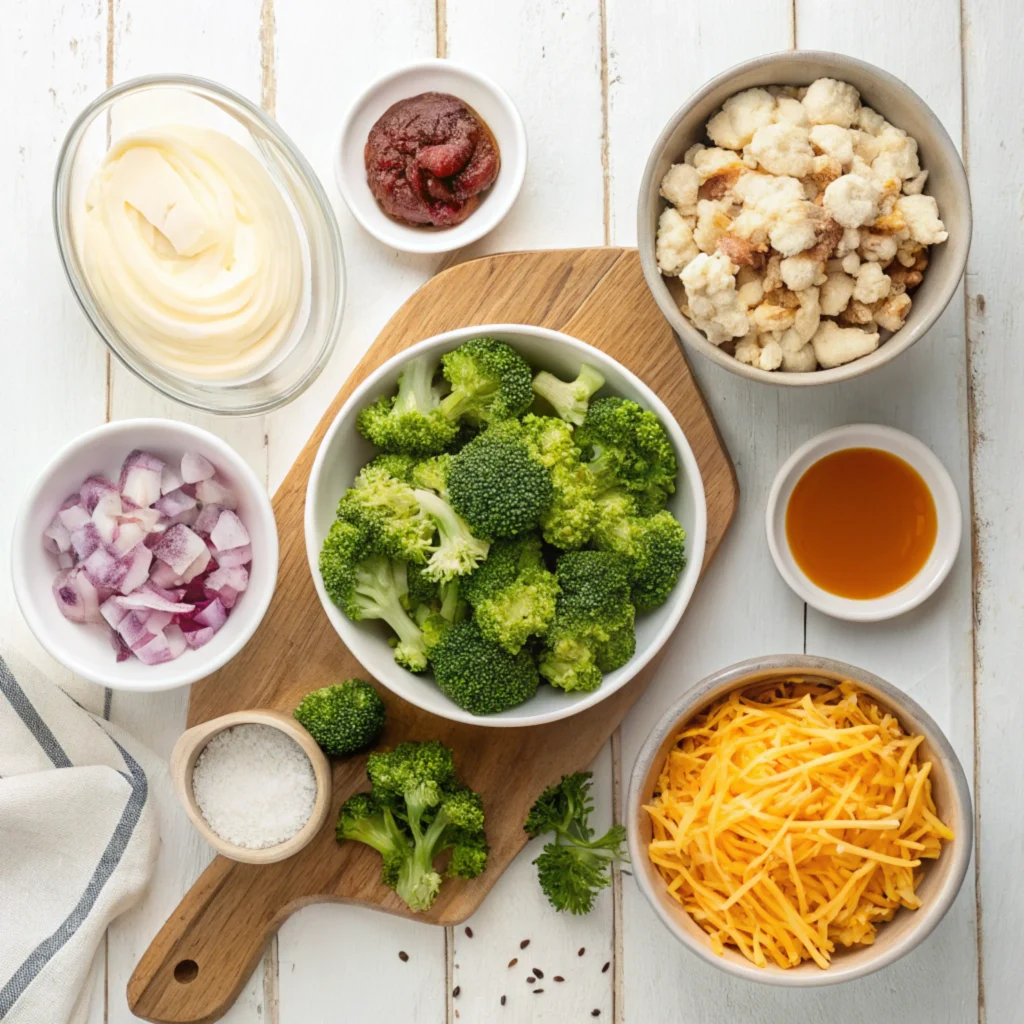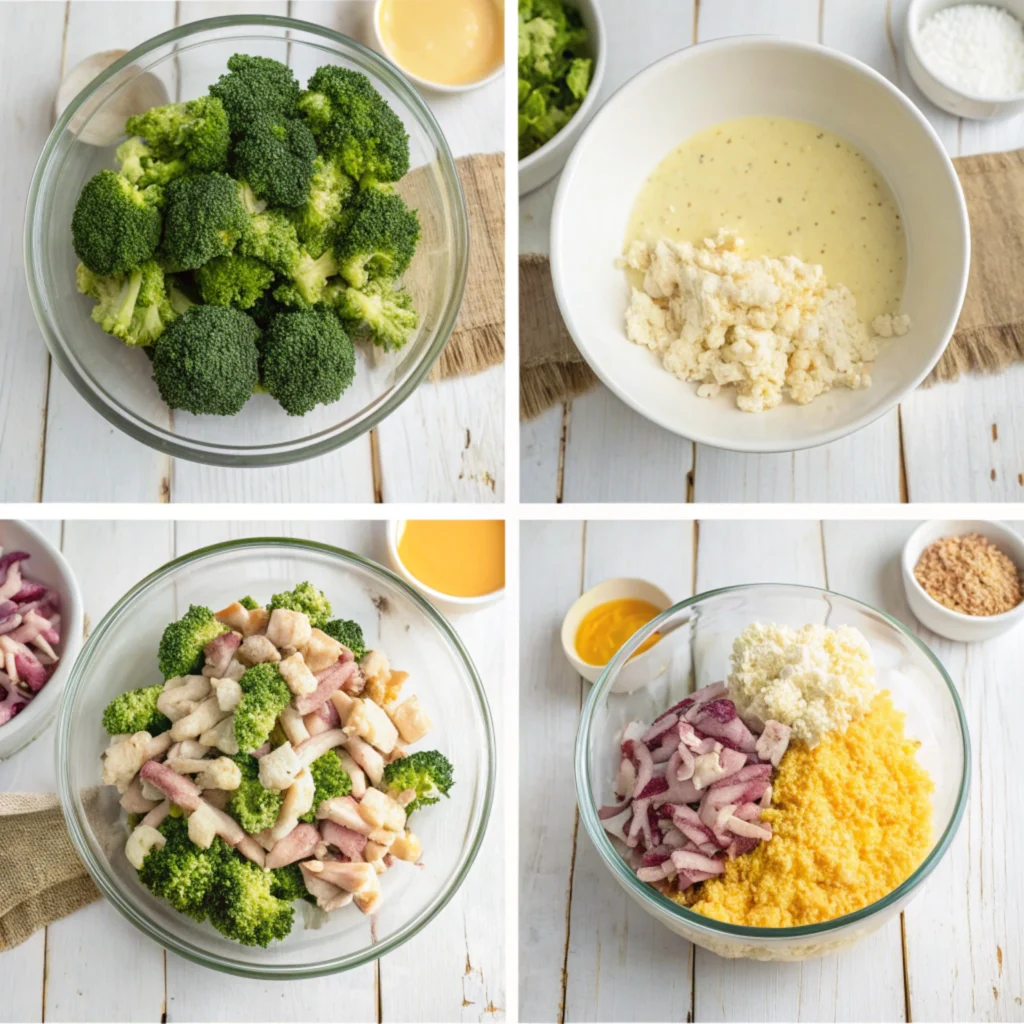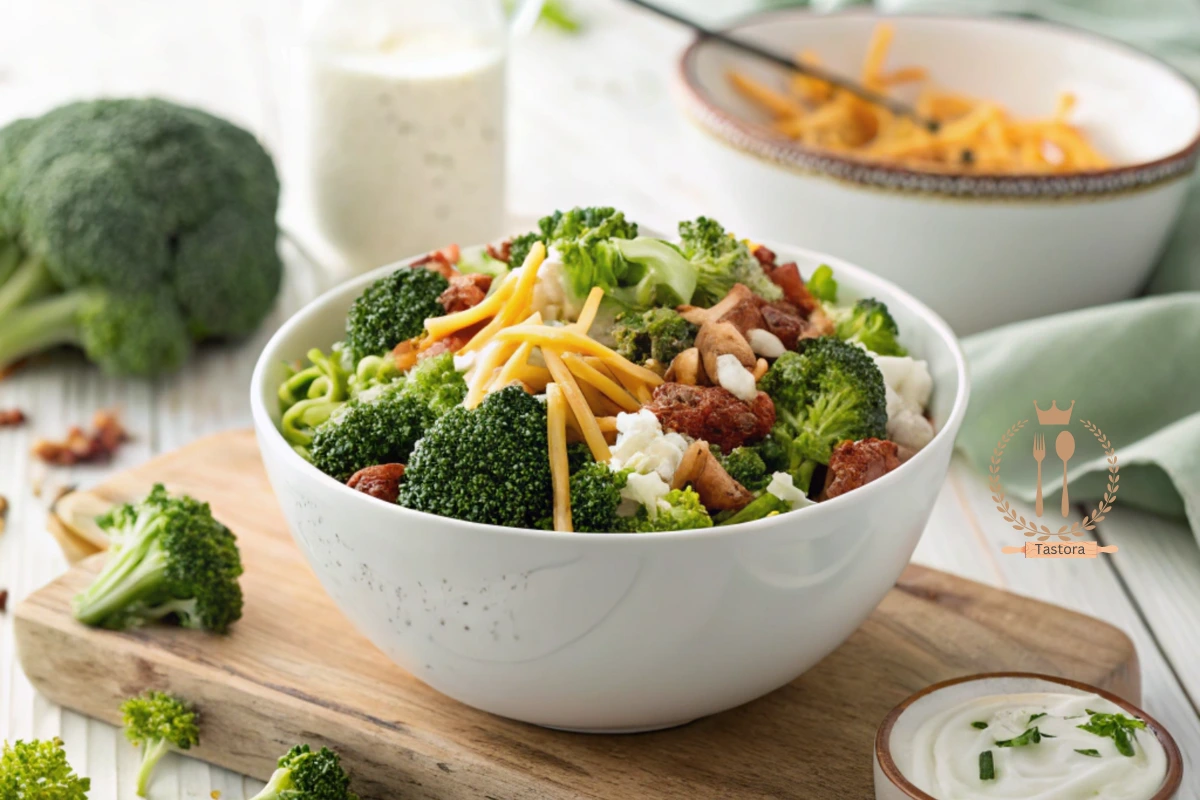The Truth About Chicken Salad Chick Broccoli Salad Nutrition
“Chicken Salad Chick Broccoli Salad nutrition“
Creamy, crunchy, and indulgently delicious – Chicken Salad Chick’s Broccoli Salad has captured the hearts (and taste buds) of Americans nationwide. This beloved side dish has become a staple accompaniment to the restaurant’s signature chicken salads, but what’s really hiding beneath those vibrant green florets and creamy dressing? If you’ve been enjoying this popular side without a second thought about its nutritional profile, you’re not alone. Today, we’re diving deep into the real story behind this fan-favorite – revealing the nutrition facts, health implications, and smart ways to enjoy this tempting treat without derailing your diet goals. Whether you’re a dedicated Chicken Salad Chick regular or just curious about making healthier choices when dining out, this comprehensive guide will give you the unvarnished truth about what you’re really eating.
What Is Chicken Salad Chick’s Broccoli Salad?
Chicken Salad Chick has established itself as a fast-casual restaurant chain specializing in chicken salad variations since its founding in 2008. With over 200 locations across the Southern and Midwestern United States, the restaurant has built a loyal following for its homestyle recipes and Southern charm.
Among their side dish offerings, the Broccoli Salad stands out as a customer favorite. This colorful side dish features fresh broccoli florets as its base, combined with sharp cheddar cheese, crispy bacon pieces, and a sweet-tangy dressing that’s primarily mayonnaise-based. Some variations include red onion, sunflower seeds, or dried cranberries for added texture and flavor complexity.
The popularity of this side dish stems from its perfect balance of flavors and textures – the crunch of raw broccoli contrasted with the creamy dressing, the saltiness of bacon complemented by a hint of sweetness. It serves as an ideal companion to their signature chicken salads, providing textural contrast and a different flavor profile that rounds out the meal experience.
Many customers appreciate that the broccoli salad offers a vegetable option among the sides, creating the perception of adding something “healthy” to their meal – though as we’ll explore later, the nutritional reality might be more complicated than it first appears.
Chicken Salad Chick Broccoli Salad Nutrition Facts
Calories Per Serving
A standard serving of Chicken Salad Chick’s Broccoli Salad (approximately 4 ounces or a half-cup portion) contains about 170-190 calories. While this might seem relatively moderate compared to some restaurant sides, it’s important to note that many customers unknowingly consume larger portions, especially when the salad is served in a to-go container where portion sizes may be less obvious. For context, this calorie count is comparable to eating about two small chocolate chip cookies, making it a relatively calorie-dense side option despite its vegetable base.
Total Fat, Saturated Fat, and Protein Content
The broccoli salad derives much of its caloric content from fat – approximately 14-16 grams per serving, with saturated fat accounting for roughly 3-4 grams. This fat content primarily comes from the mayonnaise-based dressing, cheese, and bacon components. The saturated fat content represents about 15-20% of the daily recommended limit for someone following a 2,000-calorie diet.
On the protein front, the salad provides approximately 4-5 grams per serving, primarily from the cheese and bacon bits. While broccoli itself contains some protein, the amount is relatively small compared to these animal-based ingredients. This protein content, while modest, does contribute to the salad’s satiating quality.
Carbohydrates and Sugar Levels
The carbohydrate content in Chicken Salad Chick’s Broccoli Salad totals around 10-12 grams per serving. Of particular note is the sugar content, which can range from 6-8 grams – equivalent to about 2 teaspoons of added sugar. This sweetness typically comes from sugar added to the dressing and sometimes from ingredients like dried cranberries if included in the preparation.
The fiber content, primarily from the broccoli, is approximately 2-3 grams per serving, which partially offsets the impact of the carbohydrates on blood sugar levels but doesn’t completely mitigate the effects of the added sugars.
How It Compares to Other Sides on the Menu
In the context of Chicken Salad Chick’s menu, the Broccoli Salad falls somewhere in the middle of the nutritional spectrum. It generally contains fewer calories than their mac and cheese (approximately 250-300 calories per serving) and pasta salad options (around 200-220 calories per serving). However, it typically has more calories and fat than their fresh fruit option (approximately 60-80 calories per serving) or a simple green salad with light dressing.
The broccoli salad’s sodium content is also worth noting – at approximately 300-350mg per serving, it’s lower than some other sides like the mac and cheese but still represents a significant portion (roughly 15%) of the recommended daily sodium limit in just a small side dish.
Is Chicken Salad Chick’s Broccoli Salad Healthy?


🥦 Ingredients (Serves 4–6)
- 4 cups fresh broccoli florets (washed and chopped)
- 1 cup shredded cheddar cheese
- ½ cup cooked and crumbled bacon
- ⅓ cup chopped red onion (optional)
- ¾ cup mayonnaise
- 2 tablespoons apple cider vinegar
- 2 tablespoons sugar (adjust to taste)
- Salt and black pepper to taste
👩🍳 Preparation Steps
- Prep the ingredients:
Wash and chop the broccoli into bite-sized florets. Cook the bacon until crispy, then crumble it. Chop the red onion if using. - Make the dressing:
In a mixing bowl, whisk together the mayonnaise, apple cider vinegar, and sugar until smooth and creamy. - Combine everything:
In a large bowl, add the broccoli, cheddar cheese, bacon, and onion. Pour the dressing over the top. - Mix and chill:
Toss everything together until well coated. Cover and refrigerate for at least 1 hour to let the flavors meld. - Serve:
Stir again before serving. Serve chilled as a side dish or with grilled meats for a balanced meal.
Evaluating Its Ingredients from a Health Perspective
The broccoli salad presents an interesting nutritional dichotomy. On one hand, its main ingredient – broccoli – is an undisputed nutritional powerhouse rich in vitamins C and K, folate, fiber, and various beneficial plant compounds with antioxidant and anti-inflammatory properties.
However, the health benefits of broccoli are somewhat compromised by the other ingredients. The mayonnaise-based dressing contributes significant amounts of unhealthy fats and calories without adding substantial nutritional value. The bacon adds sodium and preservatives along with saturated fat, while the added sugars in the dressing contribute empty calories that can impact blood sugar levels and overall health when consumed regularly.
The cheddar cheese does provide calcium and protein but also adds saturated fat and sodium to the overall nutritional profile. When evaluating the broccoli salad as a whole, the less nutritious components significantly dilute the health benefits of the vegetable base.
Pros and Cons Based on Common Diets
For those following specific dietary approaches, the broccoli salad presents various considerations:
Low-carb or keto diets: With approximately 10-12 grams of carbohydrates per serving, the broccoli salad can potentially fit into a low-carb diet if consumed in moderation. The high fat content aligns with keto requirements, though the sugar content might be problematic for strict ketogenic dieters aiming to stay under 20-30g of carbs daily.
Low-fat diets: The broccoli salad would generally not be recommended for those following low-fat dietary patterns due to its relatively high fat content from the mayonnaise, cheese, and bacon.
Mediterranean diet: While broccoli is fully aligned with Mediterranean diet principles, the heavy use of mayonnaise and bacon is not consistent with this heart-healthy approach that emphasizes olive oil and minimal processed meats.
Plant-based diets: Due to the bacon and cheese content, the broccoli salad is not suitable for vegetarian or vegan diets unless significantly modified.
Gluten-free diets: The broccoli salad is typically gluten-free, though cross-contamination risks exist in restaurant settings.
Portion Control and Moderation Tips
When enjoying Chicken Salad Chick’s broccoli salad, portion control becomes a critical consideration for maintaining nutritional balance. Consider these strategies:
- Share a side of broccoli salad with a dining companion rather than consuming a full portion.
- Request a half-portion or “light serving” when ordering.
- Use the visual guide of limiting your portion to approximately half a cup (about the size of a tennis ball).
- Balance your meal by pairing a small portion of broccoli salad with a leaner protein option and a simpler side like fresh fruit.
- Consider the broccoli salad an occasional treat rather than a regular side dish if you’re closely monitoring calorie or fat intake.
Whether It Fits into a Balanced Meal Plan
The broccoli salad can be incorporated into a balanced meal plan with careful consideration. While it does contribute vegetable servings and some nutritional benefits from the broccoli itself, its high calorie density and fat content mean it should be considered more of an “indulgence” side than a health-promoting vegetable option.
For those with specific health concerns, additional caution might be warranted:
- Individuals with heart disease or high cholesterol should be mindful of the saturated fat content.
- Those with high blood pressure should consider the sodium contribution.
- People with diabetes or insulin resistance should note the added sugar content.
When integrated thoughtfully – perhaps as an occasional side rather than a daily staple – the broccoli salad can be part of an overall balanced approach to eating that includes predominantly whole, minimally processed foods.
Healthier Alternatives and Customizations
How to Lighten the Salad at Home
Creating a healthier version of Chicken Salad Chick’s broccoli salad at home allows for complete control over ingredients and nutritional content. Try these modifications:
- Replace most or all of the mayonnaise with Greek yogurt for reduced fat and increased protein. A combination of 2 parts Greek yogurt to 1 part light mayonnaise maintains creaminess while cutting calories and fat.
- Reduce the added sugar in the dressing by half, or substitute with a small amount of honey or maple syrup for more natural sweetness.
- Use turkey bacon instead of regular bacon, or reduce the quantity while ensuring it’s crispy to maximize flavor impact with less fat and sodium.
- Opt for reduced-fat sharp cheddar cheese, which provides strong flavor with fewer calories, or reduce the quantity while ensuring even distribution for flavor in every bite.
- Incorporate more vegetables like grated carrots, red cabbage, or bell peppers to increase the nutrient density and fiber content while diluting the calorie-dense components.
Low-Fat or Low-Carb Ingredient Swaps
For those following specific dietary approaches, these targeted substitutions can help align the broccoli salad with your nutritional goals:
Low-fat adaptations:
- Use fat-free Greek yogurt as the dressing base
- Omit bacon entirely or use a plant-based bacon alternative
- Reduce cheese quantity by half or use a fat-free cheese variety
- Add extra vinegar and spices to compensate for flavor reduction
Low-carb adaptations:
- Eliminate added sugars completely, using a small amount of approved sweetener if necessary
- Skip any dried fruit additions that might be present in some versions
- Increase the proportion of non-starchy vegetables
- Add heart-healthy fats like avocado or chopped nuts instead of processed meats
Pairing It with Healthier Mains at Chicken Salad Chick
When dining at Chicken Salad Chick, strategic pairing can help create a more balanced meal:
- Choose one of their lighter chicken salad options, such as the “Classic Carol” which has a simpler ingredient profile, or “Olivia’s Old South” which incorporates sweet pickles and eggs for flavor without excessive additives.
- Consider a scoop of chicken salad on a bed of lettuce rather than as a sandwich to reduce the overall carbohydrate content of your meal.
- If you’re having the broccoli salad as a side, balance it with a piece of fresh fruit to add nutrients without additional fats or processed ingredients.
- Stay hydrated with water rather than adding calories through sweetened beverages.
Tips for Choosing Better Menu Options Overall
To make generally healthier choices at Chicken Salad Chick beyond just the broccoli salad considerations:
- Review nutrition information before visiting to make informed decisions aligned with your personal health goals.
- Consider the “Trim Trio” option but customize it with your healthiest choices – perhaps a scoop of one of the simpler chicken salads, fresh fruit, and a small portion of broccoli salad.
- Be mindful of portion sizes across your entire meal – many diners unknowingly consume multiple servings in a single restaurant visit.
- Look for menu items marked as “lighter” options, which typically contain fewer calories and less fat than traditional offerings.
- Don’t be afraid to make special requests – many restaurants are willing to accommodate reasonable modifications like dressing on the side or lighter portions.
FAQs About Chicken Salad Chick Broccoli Salad Nutrition
How many calories are in a serving of broccoli salad?
A typical 4-ounce serving of Chicken Salad Chick’s Broccoli Salad contains approximately 170-190 calories. However, portion sizes served in restaurants often exceed this amount, potentially doubling the calorie intake if you consume the entire side as served.
Is the broccoli salad low-carb or keto-friendly?
With approximately 10-12 grams of carbohydrates per standard serving, the broccoli salad could potentially fit into a moderate low-carb diet but might challenge the strictest keto limits, especially considering the 6-8 grams of sugar per serving. The high fat content does align with keto principles, but those on strict ketogenic diets should consume it sparingly and account for its carbohydrate contribution to daily totals.
What allergens should you watch out for in this side dish?
The primary allergens in Chicken Salad Chick’s Broccoli Salad include dairy (from the cheddar cheese) and eggs (from the mayonnaise). Those with sulfite sensitivities should also be aware that commercially prepared mayonnaise sometimes contains sulfites as preservatives. While the standard recipe doesn’t contain nuts, cross-contamination is always a possibility in restaurant settings, so those with severe allergies should exercise caution or contact the specific location for detailed allergen information.
Can you make a healthier version at home?
Absolutely! A homemade version allows complete control over ingredients and proportions. Using Greek yogurt in place of most or all of the mayonnaise can significantly reduce fat content while adding protein. Reducing or eliminating added sugars, minimizing bacon, and increasing the proportion of fresh vegetables can transform this into a genuinely nutritious side dish that retains the appealing flavors and textures of the original.
Conclusion
The Chicken Salad Chick Broccoli Salad represents a classic case of a dish that straddles the line between vegetable side and indulgent treat. While its broccoli foundation provides valuable nutrients, the addition of mayonnaise, bacon, cheese, and sugar substantially increases its calorie, fat, and sodium content – perhaps more than many customers realize when selecting what appears to be a vegetable-forward option.
Understanding the true nutritional profile of this popular side dish empowers you to make informed choices – whether that means enjoying it occasionally as a conscious indulgence, creating a healthier homemade version, or selecting alternative sides that better align with your personal health goals.
Like many restaurant offerings, the broccoli salad demonstrates that appearances can be deceiving when it comes to nutrition. What looks like a healthy vegetable dish may actually contribute significantly to daily calorie and fat intake. By approaching such foods with awareness and moderation, you can still enjoy your favorite restaurant experiences while maintaining a balanced approach to eating that supports your overall wellbeing.
Remember that no single food defines a healthy diet – it’s the pattern of choices over time that matters most. Armed with the knowledge of what’s really in that tempting side of broccoli salad, you can now decide exactly how it fits into your personal nutrition plan.
Are you ready to try this recipe?
There are no reviews yet. Be the first one to write one.


